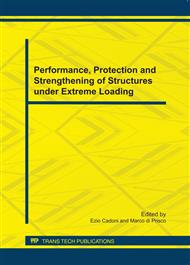p.344
p.350
p.356
p.362
p.368
p.374
p.380
p.386
p.392
The Influence of Fire Scenarios on the Structural Behaviour of Composite Steel-Concrete Buildings
Abstract:
Fire Safety Engineering can be defined as a multi-discipline based on the application of scientific and engineering principles to the effects of fire in order to reduce the loss of life and damage to property by quantifying the risks and hazards involved and provide an optimal solution to risk mitigation. The correct identification of fire scenarios is the central stage in the process of the structural fire design. A design fire scenario is the description of the spread of a particular fire with respect to time and space. In the process of identification of design fire scenarios for the structural fire safety check, all fires must be assessed realistically, choosing those most severe for the structural response. This paper is devoted to evaluate the influence of fire scenarios on the structural behaviour of composite steel-concrete buildings. In order to that, an office building subjected to different fire scenarios was considered. In particular the fire scenarios were defined by both standard fire (prescriptive approach) and natural fire (performance approach). Finally, a comparison between the prescriptive approach and the FSE approach is presented.
Info:
Periodical:
Pages:
368-373
Citation:
Online since:
July 2011
Authors:
Price:
Сopyright:
© 2011 Trans Tech Publications Ltd. All Rights Reserved
Share:
Citation:


